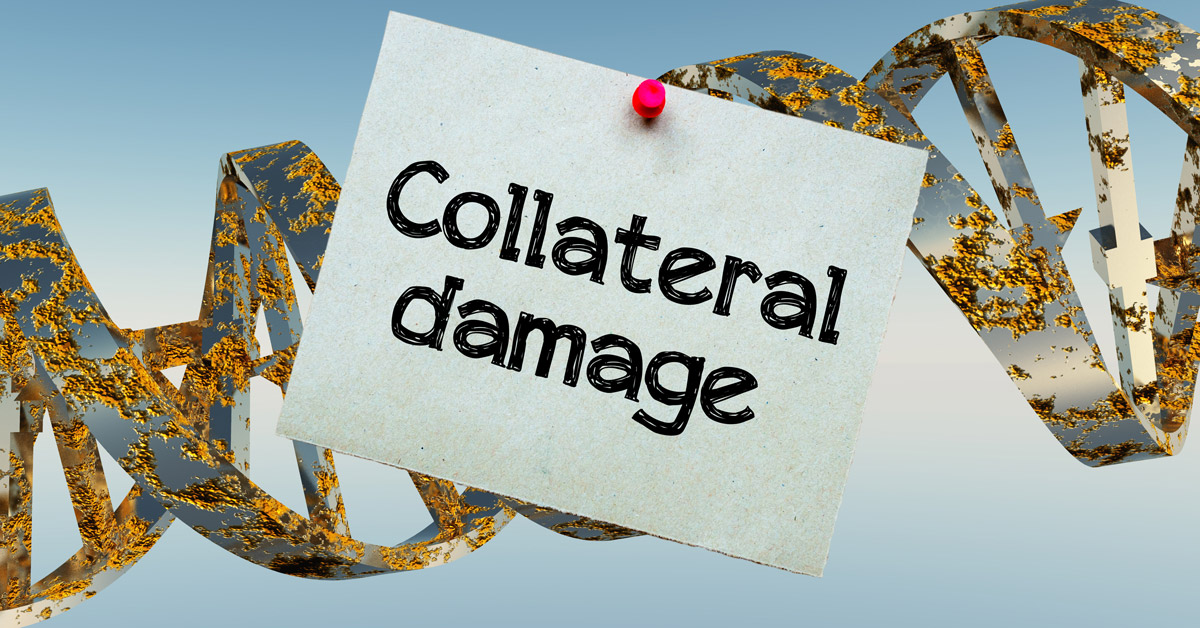
Gene editing technology remains unpredictable, say researchers
In a pattern that will be all too familiar to GMWatch readers, yet another paper has been published by researchers in the medical field, highlighting the wide range of unintended outcomes from gene editing, both at the site targeted for editing and at other locations in the genome. Meanwhile plant biotechnologists keep silent on the issue or make false claims about the supposed precision of the technology.
Here are some quotes from the new paper (see abstract below this article), which is open access:
* "The range of possible molecular events resulting from genome editing has been underestimated and the technology remains unpredictable on, and away from, the target locus."
* "When editing is used for the production of agricultural products (plants or animals), it remains unclear whether uncontrolled outcomes may pose a risk to the users. Such variability may prevent licensing for commercialization by regulators or negatively affect the confidence of consumers in the safety of those products."
* "In all applications of genome editing (whether in biomedical research, agricultural production, or the clinic) a thorough evaluation of these outcomes is necessary for a realistic appraisal of the benefit–risk ratio associated with the use of the technology."
* "Although genome editing is being developed for application across many fields (biomedical research, agricultural production, or in the clinic), much work remains to be done towards understanding the frequency, extent, and mechanisms of the sequence changes that the system produces (see Outstanding Questions). Existing genome-editing systems all rely on the uncontrolled participation of endogenous DNA repair factors and, consequently, are error-prone and not entirely predictable. An error-free system will await more sophisticated approaches that will both carry out the desired DNA repair and shield the modified locus from the intervention of endogenous DNA repair machineries."
In the final quote, the authors make a vital point that is generally glossed over by plant biotechnologists who eulogise gene editing. That is, the genetic change induced by the gene editing process takes place after the editing tool has finished its function of causing a double strand break in the DNA. The genetic change or "edit" is then dependent on the cell's innate DNA repair mechanisms, which cannot be controlled or predicted by the genetic engineer.
Given the limitations of gene-editing processes, the authors of the new paper deserve a medal for managing to drum up the optimism that an "error-free system" will ever be found. That's because such a system would necessarily entail suppressing the cell's own innate DNA repair mechanisms and somehow supplanting them with a fully controllable introduced DNA repair machinery. Thus far, no one has even tried to do this, let alone succeeded.
Perhaps conceptually it may be possible, but in reality it is a daunting task. In fact, it is so far beyond what molecular biologists can currently achieve with gene editing that we can only characterise it as speculative in the extreme.
---
Anticipating and identifying collateral damage in genome editing
Burgio, G., & Teboul, L. (2020).
Trends in Genetics, 8 October 2020.
https://www.sciencedirect.com/science/article/pii/S016895252030247X
Highlights
- Genome editing has a transformative potential in healthcare or to improve crops or livestock. However, the use of Cas9 or other nucleases can yield unpredictable events at the target site or off target.
- To overcome these challenge, it is critical to understand and accurately predict the whole range of possible editing outcomes.
- The key to success is to combine molecular assays to evaluate the sequence changes at the target site and to quantify the number of copies of segments deleted/inserted across the genome.
- For all applications, thorough evaluation of these outcomes is essential to identify all collateral damage from nuclease activity and for a real appraisal of the benefits and risks associated with applying this technology.
Abstract
Genome editing has powerful applications in research, healthcare, and agriculture. However, the range of possible molecular events resulting from genome editing has been underestimated and the technology remains unpredictable on, and away from, the target locus. This has considerable impact in providing a safe approach for therapeutic genome editing, agriculture, and other applications. This opinion article discusses how to anticipate and detect those editing events by a combination of assays to capture all possible genomic changes. It also discusses strategies for preventing unwanted effects, critical to appraise the benefit or risk associated with the use of the technology. Anticipating and verifying the result of genome editing are essential for the success for all applications.